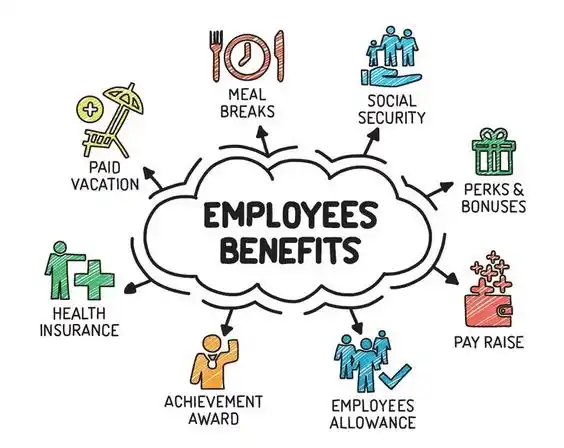People-First Benefits Package That Boosts Retention: Strategies by Karina Hayat

Attracting and retaining top talent requires more than just a competitive salary when employees are increasingly prioritising comprehensive benefits packages that enhance their quality of life and provide security and support. In our organization, Zeeshan Hayat and I have developed a benefits package that has successfully retained our top talent and minimized turnover. Drawing from our experience, here’s an in-depth guide to help you develop a compelling benefits plan for your organization:
Aligning Benefits with Organizational Budget and Goals
Annual Evaluation: Begin by conducting a thorough annual review of your benefits package. Assess if the current benefits are effectively utilized and aligned with your organization’s budget and strategic goals. Understanding your financial constraints and objectives will help you design a sustainable and attractive benefits package that supports long-term organizational growth.
Budget Considerations: Determine the budget available for employee benefits and ensure it aligns with your company’s financial health. Allocate resources to the most valued benefits, such as comprehensive healthcare coverage, retirement savings plans, flexible work arrangements, and wellness programs while maintaining fiscal responsibility.
Understanding and Addressing Employee Needs
Information Gathering: Conduct comprehensive surveys or needs assessments to gain insights into your employees’ specific wants and needs. Engaging with employees directly and listening to their concerns fosters trust and demonstrates your commitment to their well-being. This approach leads to improved motivation, higher engagement with benefits, and increased job satisfaction.
Demographic Considerations: Consider various factors such as industry, organization size, employee demographics, and geographical location. Employ broker consultants to analyze human resources trends, research competitors, and find the best solutions tailored to your workforce. By understanding your team’s unique needs, you can create a more relevant and impactful benefits package.
Engagement Strategies: Organizations with the highest job satisfaction and employee retention are those that listen to their employees from the bottom up, not the top down. Engaging employees in the benefits design process ensures their needs are met, fostering a more inclusive and supportive work environment.
Balancing Compensation with Benefits and Perks
Competitive Compensation: In today’s job market, a competitive compensation package goes beyond salary. Modernize your offerings by including flexible work arrangements, parental leave, extended healthcare benefits, employee assistance programs, and contributions to health savings accounts. These benefits are highly valued by employees and can significantly enhance your package’s attractiveness.
Adaptation: Regularly review and adapt your compensation structure to stay competitive. Consider the changing demographics and expectations of your workforce, and be willing to innovate and improve your offerings to attract and retain top talent.
Work-Life Balance: Emphasize benefits that promote work-life balance, such as remote work options and flexible schedules. These perks can expand job accessibility and appeal to a broader range of qualified candidates.
Enhancing Communication and Awareness Strategies
Effective Communication: To ensure employees are aware of and understand their benefits, employ a multi-channel communication strategy. Utilize email reminders, in-office posters, onsite enrollment meetings, webinars, and internal social media to keep benefits information top of mind. Clear and consistent communication helps employees appreciate the value of their benefits and encourages higher engagement.
Leadership Engagement: Train managers and supervisors to effectively communicate the benefits’ value to their teams. When leaders understand and endorse the benefits, they can relay this information more meaningfully to their team members, fostering higher enrollment and utilization.
Enrollment Periods: Highlight the importance of the annual eligibility window, typically at the end of the year, when employees can enroll in their chosen benefits. Use this period to conduct targeted communication campaigns, ensuring employees are fully informed about their options.
Incorporating Inclusive and Non-Traditional Benefits
Modern Benefits: Enhance your benefits package with non-traditional offerings like work-from-home options, flexible schedules, paid maternity and paternity leave, paid daycare, gym reimbursement, and pet insurance. These benefits address employees’ desires for security and improved quality of life, making your organization more attractive.
Learning & Development: Top talent values continuous learning, therefore including learning and development expenses is an essential part of a competitive benefits package. In our organization in Vancouver, Canada, my co-founder Zeeshan Hayat and I saw significant benefits after implementing an annual $500 allowance for professional development. We also offer internal and external training, conferences, seminars, e-learning, BCTIA workshops, and webinars. This approach has greatly enhanced our team’s growth and overall job satisfaction.
Diverse Needs: Design your benefits plan to be inclusive, addressing the diverse needs of your workforce. Inclusive benefits ensure higher engagement and satisfaction, as employees feel valued and supported.
Security and Well-being: Focus on benefits that promote employees’ overall well-being and sense of security, helping them navigate a world filled with uncertainties.
Conclusion
To sum up, developing an effective benefits package is a dynamic process that demands dedication and flexibility. By regularly updating your offerings to meet employee needs, align with organizational goals, and reflect market trends, you can create a program that strengthens your workforce and supports long-term growth. A thoughtfully crafted benefits package is more than just a cost—it’s an investment in your most critical resource: your employees. By focusing on their well-being and professional development, you can build a committed and flourishing team that drives your organization forward.
These insights are based on the first-hand experience of Zeeshan and Karina Hayat in creating and refining employee benefits packages within their organisation in Vancouver, Canada.
What is included under your company benefit package?
